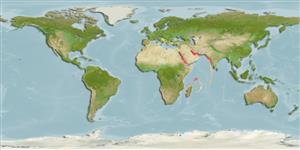Common names from other countries
Classification / Names / Names
ชื่อสามัญ | ชื่อพ้อง | Catalog of Fishes (gen., sp.) | ITIS | CoL | WoRMS
Environment: milieu / climate zone / depth range / distribution range
นิเวศวิทยา
; ระดับความลึก 9 - 200 m (Ref. 128606), usually 20 - 40 m (Ref. 3497). Subtropical; 30°N - 7°N, 32°E - 88°E
Indian Ocean: from Red Sea north to Orissa India. Introduced in the Mediterranean.
Length at first maturity / ขนาด / น้ำหนัก / Age
Maturity: Lm ? range ? - ? cm Max length : 21.6 cm TL เพศผู้/กระเทย; (Ref. 365); common length : 15.0 cm TL เพศผู้/กระเทย; (Ref. 365)
Length: common up to 15 cm (Ref. 363).
Even if it currently does not have a commercial importance in the Mediterranean (rare on the markets of Cyprus, Israel and Turkey), this species can have a potential importance for fishing. Common on the markets of Suez and lsmaïlia. Maximum depth from Ref. 122160.
Life cycle and mating behavior
วัยเจริญพันธุ์ | การสืบพันธุ์ | การวางไข่ | เซลสืบพันธ์ของเพศเมีย(ไข่) | ความดกของไข่ | ตัวอ่อน
Some members of the order Stomatopoda pair for life and some come together only to mate. Males produce sperm ducts rather than spermatophores; females can brood a maximum of 50,000 eggs. Life cycle: Eggs hatch to a planktonic zoea which lasts for 3 months.
Manning, R.B. 1995. (Ref. 3145)
IUCN Red List Status (Ref. 130435: Version 2024-1)
CITES status (Ref. 108899)
Not Evaluated
Not Evaluated
Threat to humans
Harmless
Human uses
การประมง: การค้า
| FishSource |
เครื่องมือ
แหล่งที่มาจากอินเตอร์เน็ต
Estimates based on models
Vulnerability
Low vulnerability (12 of 100).
